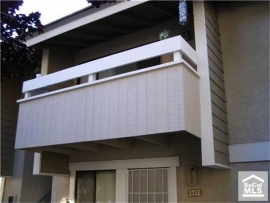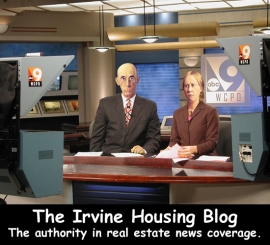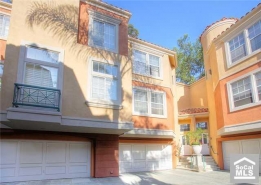In another remarkably foolish proposal to pander to loan owners, Representative Marcy Kaptur of Ohio proposes a freeze on foreclosures to give squatters more free housing.


Irvine Home Address … 328 STREAMWOOD Irvine, CA 92620
Resale Home Price …… $215,000

Anything you want, you got it.
Anything you need, you got it.
Anything at all, you got it.
Baby!
Anything you want
Anything you need
Anything at all
Roy Orbison — You Got It
Most politicians live to pander. Tax dollars are viewed as an ATM machine they can go to whenever they want to buy enough votes to get re-elected. Pork-barrel politics is a way of life in Washington.
Foreclosure Freeze Proposed
By Mike Colpitts — July 12, 2011 
An Ohio member of Congress has proposed a resolution that would enact a temporary freeze on foreclosures across the U.S. similar to the Great Depression. The proposal would enact a moratorium on all residential foreclosures.
Rep. Marcy Kaptur (D-OH) offered the resolution before the House Financial Services Committee. The proposal asks President Barack Obama to declare a “national residential mortgage foreclosure emergency,” and also urges state lawmakers to use their “police powers” to enact moratoriums on foreclosures.
This is the dumbest idea I have heard in quite a while. It's obvious this congressional representative has given no thought to the ramifications of what she is proposing.
First, there is no emergency. Foreclosures are the cure, not the disease. This is like telling a patient suffering from acute appendicitis that they shouldn't get an appendectomy. The debt burdenening the population is the real problem. Housing debt is extinguished in foreclosure.
Second, if this were enacted, wouldn't everyone on the fringe strategically default? Anyone struggling with their payments would know they can't be foreclosed on and evicted, so why would they continue to struggle? Further, wouldn't this be grossly unfair to everyone who does make their payments? Why would anyone keep making their payments when they could live in the house for free?
Stupid ideas like these come from a complete misunderstanding of the problem and how housing finance works. If the borrowers who can't live up to their financial obligations do not experience the negative consequences of their actions, then no borrower will exercise any judgment prior to taking free money.
No private lender would loan money if they don't have any assurance they will get repaid or otherwise get to foreclose and obtain their loan capital. If the government were to continue underwriting and insuring these loans, everyone will eventually be living in free government housing. The process would be to apply for a loan, get the property, then stop making payments and live there for nothing. Perhaps some fools would continue to pay, but with no possibility of foreclosure, why would anyone pay?
The final and most pernicious effect of a foreclosure moratorium is to extend the duration of the economic downturn. Freezing foreclosures does nothing but buy time for those on foreclosure's death row, keep capital tied up in non-performing assets, and prolong everyone's misery.
The resolution sites a variety of issues troubling the housing market stating, “Whereas the United States finds its housing market in a precarious and unstable state, where homeowners' mortgage balances are routinely larger than the current value of their homes and where people are losing their homes at an alarming rate.
People who owe more than the house is worth don't own anything. Further, new families find the homes lost in foreclosure. The house isn't misplaced, it simply passes from someone who can't afford the debt service to someone who can. A foreclosure moratorium is a slap in the face to everyone who is waiting to buy one of these homes. Existing loan owners are being favored over the next generation of buyers for no good reason.
“The President of the United States should declare a national residential mortgage foreclosure emergency and, through such declaration, encourage the States, by use of their police power, to enact a moratorium on residential mortgage foreclosures similar to the moratorium enacted by the State of Minnesota in 1933 and upheld by the Supreme Court.”
This isn't the first time such a dumb idea has been floated. George Bush and Hillary Clinton both announced similar ideas in March of 2008. It was a dumb idea that gained no traction back then, and it's still a dumb idea now.
The Minnesota Mortgage Moratorium Act of 1933 was controversial when it was upheld by the Supreme Court because the state was interfering with private contracts under the guise of an emergency. There is no emergency here, other than Ms. Kaptur's desire to pander to loan owners.
Kaptur represents Ohio, which has been devastated by the foreclosure crisis and is one of 18 states designated for the federal government’s Hardest Hit Fund targeted to help mostly unemployed homeowners at risk of losing their homes to foreclosure. Rising unemployment in the region is triggering a massive second wave of foreclosures in many areas of the state, including hard hit Cleveland.
A foreclosure freeze would give lenders’ and homeowners time to work out a solution on millions of home mortgages that are forecast to be foreclosed in the next five years.
What solution is there to work out? Haven't lenders and borrowers had over four years of wrestling with this problem? In reality, there is only one solution that will allow borrowers to keep their homes: BORROWERS NEED TO MAKE LOAN PAYMENTS. It isn't very complicated when you think about it.

The problem is that borrowers want to keep their houses without making loan payments, and that option isn't in their contract. They can quit making payments and leave the house at any time. That option is in their contract. They can try to work out a loan modification, but that is not an entitlement, and lenders don't like to unilaterally change the contract in favor of the borrower.
Not everyone agrees with Ms. Kaptur, fortunately. Back in March of 2009, I asked the question are foreclosures a Crisis or Cure?
Some people should never have been given the loans they had; they can't afford the properties they occupy. Today's featured property is beyond the means of its owners, so it is going into foreclosure. Is this foreclosure a crisis? or is is the cure to their debt problems? …
As a society, we need to stop viewing this as a “foreclosure crisis.” There is no foreclosure crisis; there is a debt disease, and foreclosure is the cure.
Jamie Dimon, CEO of JP Morgan/Chase, is quoted as saying “Giving debt relief to people that really need it, that's what foreclosure is.” He is right; Foreclosure Is a Superior Form of Principal Reduction.
It's a few years late, but others have noted the same thing:
Foreclosures Are the Solution, Not the Problem
By Philip van Doorn — 07/11/11
NEW YORK (TheStreet) — Former Federal Deposit Insurance Corp. Chairman Sheila Bair made some excellent points in her Washington Post Op-ed piece Monday but overlooked one important point: The U.S. needs to double down on foreclosures.
To the former regulator, forgiveness is the answer. Bair said that the banks had showed a “stubborn refusal to deal head-on with past-due and underwater mortgages,” and that it was “time for banks and investors to write off uncollectible home equity loans and negotiate new terms with distressed mortgage borrowers that reflect today's lower property values.”
True enough.
No, it's not true enough. Investors do need to write off their uncollectible second mortgages, that much is true, but lenders have no obligation to renegotiate terms with delinquent mortgage squatters to give them principal forgiveness. That would merely lead to more irresponsible borrowing.
But why should the banks automatically write off any second-mortgage or home equity line of credit that goes delinquent? If word were to get out, any borrower who was actually in a position to comfortably make their first mortgage payment, plus a payment on a second mortgage, would seriously consider a “strategic default.” They wouldn't lose their homes under Bair's plan.
Bair does place some blame on consumers, saying that leading into the credit crunch, “it became old-fashioned to save up for the down payment on that first home,” and that “taking out a mortgage shifted from the most serious financial decision a family would make to a speculative bet on how far home prices would rise.“
No, ramping up writedowns isn't the only answer. Want to save the banking system and restart the housing market. Why not also step up foreclosures?
Lenders should step up foreclosures. Government should encourage this because foreclosures are essential to the economic recovery and foreclosures will drive the national economic recovery. Barry Ritholtz laid out the case for more foreclosures brilliantly back in March of 2010 in More Foreclosures, Please …
Now we get to the ugly Truth: The mortgage mods and foreclosure abatement programs are really all about propping up insolvent banking institutions on the taxpayer dollar and at the expense of the middle class. These programs are another losing round of helping Wall Street at the expense of Main Street. It is the worst kind of trickle down economics.
Herbert Spencer wrote, “The ultimate result of shielding men from the effects of folly is to fill the world with fools.” We have done precisely that.
An Option ARM success story?
The Option ARM was the most toxic loan program ever developed, but a few people actually made this loan work for them. Today's featured property owners are the first I have ever seen who used this loan responsibly.
This property was bought on 10/1/2001 for $158,000. The owners used a $150,000 first mortgage and a $8,000 down payment. On 7/15/2003 they refinanced with an option ARM for $151,000, and they never refinanced after that. They did obtain a HELOC for $35,000 on 12/22/2010, but there is no evidence they used it.
With the insanity going on around them, these people used and Option ARM responsibly and apparently paid down their mortgage. Despite the housing crash, they are obtaining a small profit on the sale, and their credit will remain solid.
I wonder if they regret not taking the free money when they could have obtained a $400,000 loan on this property back in 2006? I hope they don't.
——————————————————————————————————————————————-
This property is available for sale via the MLS.
Please contact Shevy Akason, #01836707
949.769.1599
sales@idealhomebrokers.com


Irvine House Address … 328 STREAMWOOD Irvine, CA 92620
Resale House Price …… $215,000
Beds: 2
Baths: 1
Sq. Ft.: 857
$251/SF
Property Type: Residential, Condominium
Style: One Level, Other
View: City Lights, Creek/Stream
Year Built: 1977
Community: Northwood
County: Orange
MLS#: S665780
Source: SoCalMLS
Status: Active
——————————————————————————
Spacious condo with ceramic tile floors. Mirrored closet doors in master bdrm, vaulted ceiling in living & dining rooms. Private balcony overlooking water streams and beautiful landscape. Excellent Schools SANTIAGO ELEMENTARY & NORTHWOOD HIGH SCHOOL. Walk to shops, banks, UPS store, restaurants and groceries. Extremely accessible location, close to schools, freeways, and parks. HOA dues include water, trash, insurance. Great community amenities include pool, spa & tennis courts and more. NOT A REO OR SHORT SALE.
——————————————————————————————————————————————-
Proprietary IHB commentary and analysis ![]()
With 4.5% interest rates, this condo is probably more affordable today than it was in 2001 when incomes were lower and interest rates were higher. At $1,467 per month cost of ownership, it is at or below rental parity for someone wanting to live in an 857 SF 2/1 condo. These units should trade for prices below rental parity. This family has lived there for 10 years. That's a long time for such a small space.
Resale Home Price …… $215,000
House Purchase Price … $158,500
House Purchase Date …. 10/1/2001
Net Gain (Loss) ………. $43,600
Percent Change ………. 27.5%
Annual Appreciation … 3.1%
Cost of Home Ownership
————————————————-
$215,000 ………. Asking Price
$7,525 ………. 3.5% Down FHA Financing
4.59% …………… Mortgage Interest Rate
$207,475 ………. 30-Year Mortgage
$45,530 ………. Income Requirement
$1,062 ………. Monthly Mortgage Payment
$186 ………. Property Tax (@1.04%)
$0 ………. Special Taxes and Levies (Mello Roos)
$45 ………. Homeowners Insurance (@ 0.25%)
$239 ………. Private Mortgage Insurance
$242 ………. Homeowners Association Fees
============================================
$1,774 ………. Monthly Cash Outlays
-$98 ………. Tax Savings (% of Interest and Property Tax)
-$269 ………. Equity Hidden in Payment (Amortization)
$13 ………. Lost Income to Down Payment (net of taxes)
$47 ………. Maintenance and Replacement Reserves
============================================
$1,467 ………. Monthly Cost of Ownership
Cash Acquisition Demands
——————————————————————————
$2,150 ………. Furnishing and Move In @1%
$2,150 ………. Closing Costs @1%
$2,075 ………… Interest Points @1% of Loan
$7,525 ………. Down Payment
============================================
$13,900 ………. Total Cash Costs
$22,400 ………… Emergency Cash Reserves
============================================
$36,300 ………. Total Savings Needed
——————————————————————————————————————————————————-
Have a great weekend,
IrvineRenter


































 IHB: Distressed sales reset market pricing. Delusional sellers with WTF asking prices don't count. Further, if sales were robust and demand were strong, distressed properties would not need to be discounted in order to sell. In a weak demand market, all sales will be below recent comps. Lowering price is the only way to generate sufficient buyer interest to sell property.
IHB: Distressed sales reset market pricing. Delusional sellers with WTF asking prices don't count. Further, if sales were robust and demand were strong, distressed properties would not need to be discounted in order to sell. In a weak demand market, all sales will be below recent comps. Lowering price is the only way to generate sufficient buyer interest to sell property.











 Why should working renters care if loan owners are allowed to continue to occupy real estate they are not paying for? And why should working renters subsidize loan owners? Either give all unemployed increased benefits or let loan owners lose their houses. Why isn't anyone upset about renters getting kicked out of their homes?
Why should working renters care if loan owners are allowed to continue to occupy real estate they are not paying for? And why should working renters subsidize loan owners? Either give all unemployed increased benefits or let loan owners lose their houses. Why isn't anyone upset about renters getting kicked out of their homes?





 It's called amend-extend-pretend, and all the lenders are doing it. Whether the program is formalized or not, lenders have been accumulating delinquent borrowers in shadow inventory for years, and they will continue to do so as long as the resale market is too weak to absorb the inventory.
It's called amend-extend-pretend, and all the lenders are doing it. Whether the program is formalized or not, lenders have been accumulating delinquent borrowers in shadow inventory for years, and they will continue to do so as long as the resale market is too weak to absorb the inventory.
 Exactly. How can banks reward the least prudent borrowers in their portfolio at the expense of everyone else?
Exactly. How can banks reward the least prudent borrowers in their portfolio at the expense of everyone else?